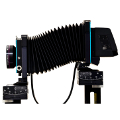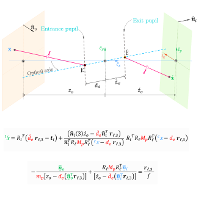|
|
|
|
|
JOURNAL PAPERS
2017

“Geometric model for an independently tilted lens and sensor with application for omnifocus imaging,” Indranil Sinharoy, Prasanna Rangarajan, Marc P. Christensen, OSA Applied Optics Special Issue on Modern Optics, 2017.
[PDF] [MORE]

“Active computational imaging for circumventing resolution limits at macroscopic scales,” Prasanna Rangarajan, Indranil Sinharoy, Marc P. Christensen, Predrag Milojkovic, OSA Applied Optics Special Issue on Modern Optics, 2017.
[PDF] [MORE]
CONFERENCE PAPERS
2016
 “Omnifocus image synthesis using Lens Swivel,” Indranil Sinharoy, Prasanna Rangarajan, Marc P. Christensen, OSA Topical meeting on Imaging Systems & Applications, 2016.
“Omnifocus image synthesis using Lens Swivel,” Indranil Sinharoy, Prasanna Rangarajan, Marc P. Christensen, OSA Topical meeting on Imaging Systems & Applications, 2016.
[PDF] [MORE]
2014
 “Optical super resolution using a lattice of light spots,” Prasanna Rangarajan, Indranil Sinharoy, Marc P. Christensen, Predrag Milojkovic, OSA Topical meeting on Computational Imaging, 2014.
“Optical super resolution using a lattice of light spots,” Prasanna Rangarajan, Indranil Sinharoy, Marc P. Christensen, Predrag Milojkovic, OSA Topical meeting on Computational Imaging, 2014.
[PDF] [MORE]
2012
 “A critical review of the slanted-edge method for color SFR measurement,” Prasanna Rangarajan, Indranil Sinharoy, Marc P. Christensen, Predrag Milojkovic, OSA Topical meeting on Imaging Systems & Applications, 2012.
“A critical review of the slanted-edge method for color SFR measurement,” Prasanna Rangarajan, Indranil Sinharoy, Marc P. Christensen, Predrag Milojkovic, OSA Topical meeting on Imaging Systems & Applications, 2012.
[PDF] [MORE]
2011
 “Pushing the limits of digital imaging using Structured Illumination,” Prasanna Rangarajan, Indranil Sinharoy, Panos Papamichalis, Marc P. Christensen , Proc. 13th IEEE International Conference on Computer Vision, ICCV 2011.
“Pushing the limits of digital imaging using Structured Illumination,” Prasanna Rangarajan, Indranil Sinharoy, Panos Papamichalis, Marc P. Christensen , Proc. 13th IEEE International Conference on Computer Vision, ICCV 2011.
[PDF] [MORE]
 “Space-Variant Optical Super-Resolution using Sinusoidal Illumination,” Prasanna Rangarajan, Vikrant R. Bhakta, Indranil Sinharoy, Manjunath Somayaji and Marc P. Christensen, Computational Optical Sensing and Imaging (COSI),Toronto, Canada, July, 2011.
“Space-Variant Optical Super-Resolution using Sinusoidal Illumination,” Prasanna Rangarajan, Vikrant R. Bhakta, Indranil Sinharoy, Manjunath Somayaji and Marc P. Christensen, Computational Optical Sensing and Imaging (COSI),Toronto, Canada, July, 2011.
[PDF] [MORE]
2008
 “Model-Based Region-Of-Interest estimation for adaptive resource allocation in multi-aperture imaging systems,” Indranil Sinharoy, Scott C. Douglas, Dinesh Rajan, Marc P. Christensen, IEEE Int. Conf. Acoust., Speech, Signal Processing (ICASSP), Las Vegas, Nevada,pp. 1961-1964, Apr. 2008.
“Model-Based Region-Of-Interest estimation for adaptive resource allocation in multi-aperture imaging systems,” Indranil Sinharoy, Scott C. Douglas, Dinesh Rajan, Marc P. Christensen, IEEE Int. Conf. Acoust., Speech, Signal Processing (ICASSP), Las Vegas, Nevada,pp. 1961-1964, Apr. 2008.
[PDF] [MORE]
2007

“Region-of-interest estimation for adaptive resource allocation in multi-aperture imaging systems,” I. Sinharoy, S.C. Douglas, IEEE Int. Conf. Acoust., Speech, Signal Processing (ICASSP), Honolulu, HI, vol. 2, pp. 597-600, Apr. 2007.
[PDF] [MORE]
THESIS
2016
 “Scheimpflug with Computational Imaging to Extend the Depth of Field of Iris Recognition Systems,” Indranil Sinharoy, Southern Methodist University, December 2016.(PhD dissertation)
“Scheimpflug with Computational Imaging to Extend the Depth of Field of Iris Recognition Systems,” Indranil Sinharoy, Southern Methodist University, December 2016.(PhD dissertation)
[PDF] [MORE]
2006
 “Region-of-interest estimation for adaptive resource allocation in multi-aperture imaging systems,” Indranil Sinharoy, Southern Methodist University, December 2006.(Master’s thesis)
“Region-of-interest estimation for adaptive resource allocation in multi-aperture imaging systems,” Indranil Sinharoy, Southern Methodist University, December 2006.(Master’s thesis)
[PDF] [MORE]
OTHERS
Non-peer reviewed papers, technical articles, pre-prints.
2016
“Geometric model of image formation in Scheimpflug cameras,” Indranil Sinharoy, Prasanna Rangarajan, and Marc P. Christensen, PeerJ Preprints 4:e1887v1.
2015
“Array ray tracing in Zemax OpticStudio from Python using the DDE extension,” Indranil Sinharoy, Knowledgebase article for Zemax.
2014
“Talking to ZEMAX from Python using PyZDDE,” Indranil Sinharoy, Knowledgebase article for Zemax.
2004
“Image Denoising Using Modified Neighshrink Algorithm,” Indranil Sinharoy, Tech. Report, Southern Methodist University 2012.
[PDF]